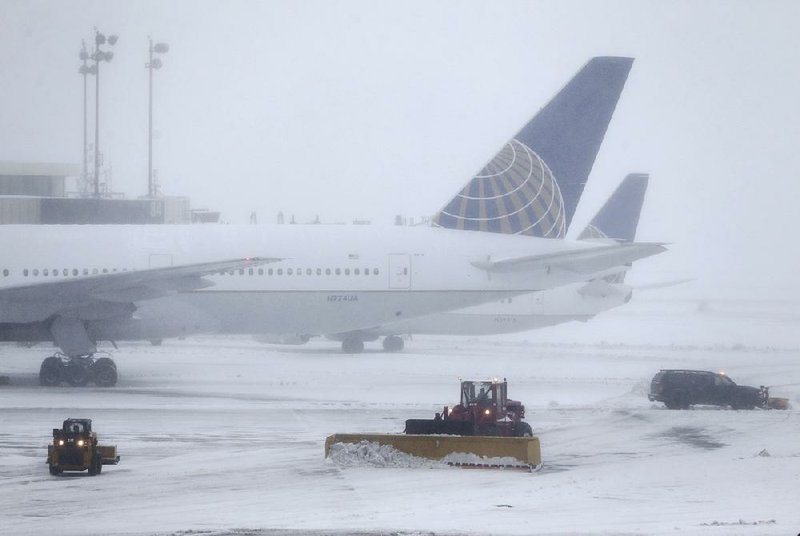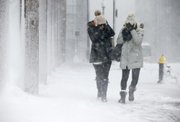NEW YORK -- A blustery, late-season storm plastered the Northeast with sleet and snow Tuesday, paralyzing much of the Washington-to-Boston corridor after a stretch of unusually mild winter weather.
The powerful nor'easter fell well short of the predicted snow totals in New York and Philadelphia but unloaded 1 to 2 feet in many places inland, grounded more than 6,000 flights and knocked out power to nearly 250,000 customers from Virginia northward.
By the time it reached Massachusetts, it had turned into a blizzard, with near hurricane-force wind gusting over 70 mph along the coast and waves crashing over sea walls. Up to a foot of snow was expected in the Boston area.
It was easily the biggest storm in a merciful winter that had mostly spared the Northeast, and many weren't happy about it.
[WINTER STORM STELLA: Interactive map of recorded snowfall]
"It's horrible," said retired gumball-machine technician Don Zimmerman of Lemoyne, Pa., using a snowblower to clear the sidewalk along his block. "I thought winter was out of here. ... It's a real kick in the rear."
While people mostly heeded dire warnings to stay home and off the roads, police said a 16-year-old girl was killed when she lost control of her car on a snowy road and hit a tree in Gilford, N.H.
In East Hartford, Conn., an elderly man died after being struck by a snow plow.
The storm closed schools in cities big and small, Amtrak suspended service and the post office halted mail delivery.
Philadelphia and New York City got a layer of snow, in some places half a foot deep, before the storm switched over mostly to sleet; forecasters had predicted a foot or more.
In New Jersey, which saw rain or just a little snow in many areas, Gov. Chris Christie called the storm an "underperformer." But officials warned of dangerous ice.
Forecasters were expecting moderate coastal flooding in New England.
"You have waves building offshore," said Kim Buttrick of the National Weather Service in Taunton, Mass. "This storm will pound the coast, especially for our northeast- and east-facing shore lines. There'll be beach erosion, some flooding of roadways, possible damage to marinas."
Inland areas, meanwhile, got hit hard. Harrisburg, Pa., and Worcester, Mass., received 1 foot or more of snow. The Binghamton, N.Y., area got more than 2 feet, while Vernon, N.J, had at least 19 inches.
Tony Brooks, a city councilman from Wilkes-Barre, Pa., said that by midafternoon Tuesday, Wilkes-Barre had more than 2 feet of snow, the most of any storm since 1996. He said that the city was at an "absolute standstill" and that the only people on the streets were college students who were enjoying the snow. "There is not a soul on the street except college students," he said.
The storm came just days after temperatures climbed into the 60s in the region, and less than a week before the official start of spring. February, too, was remarkably warm.
"The winters seem to be upside down now. January and February are nice and then March and April seem to be more wintry than they were in the past," said Bob Clifford, who ventured out on an early morning grocery run for his family in Altamont, near Albany, N.Y.
His advice: "Just hide inside. Hibernate."
Gov. Dannel Malloy of Connecticut agreed: "It's a good day to make brownies."
In the nation's capital, nonessential federal employees were given the option of reporting three hours late, taking the day off or working from home. The city got less than 2 inches of snow.
A few days ago, workers on Washington's National Mall were making plans to turn on the fountains.
"Obviously all that has to come to an abrupt stop until we get all the snow cleared," said Jeff Gowen, the acting facility manager for the National Mall and Memorial Parks. "The cherry blossoms, they're right on the cusp of going into bloom here. I had a feeling this was going to happen."
As the storm closed in, the National Weather Service used terms like "life-threatening" and urged people to "shelter in place," language that has come to be associated with mass shootings. In the end, the line between snow and rain shifted slightly to the west, sparing some of the Northeast's big cities.
Government meteorologists realized by late Monday afternoon that there was a good chance the storm wasn't going to produce the giant big-city snow totals predicted. But they didn't change their forecast for fear people would mistakenly think the storm was no longer dangerous, said Greg Carbin, chief of forecast operations at the Weather Prediction Center.
The flight cancellations included nearly 3,300 in the New York City area alone. Hundreds of passengers were stranded at airports.
Laura and Matthew Balderstone of West Yorkshire, England, intended to spend their honeymoon in Florida but found themselves stuck at the Newark, N.J., airport and couldn't find a hotel room.
"It's better safe than sorry, especially flying. I suppose it's a shame that we can't get another way around this," Matthew Balderstone said. "It's just the way it is, unfortunately."
Information for this article was contributed by Mark Scolforo, Marc Levy, Michael Hill, John Kekis, Mark Pratt, Bruce Shipkowski, Michelle R. Smith, Jennifer McDermott, Dave Collins, Shawn Marsh, Kristen DeGroot, Holly Ramer, Ted Shaffrey, Ben Nuckols, Bob Bukaty and Michael Rubinkam of The Associated Press and by Marc Santora, Ruth Bashinksy, Jessica Bidgood and Kristin Hussey of The New York Times.
A Section on 03/15/2017

